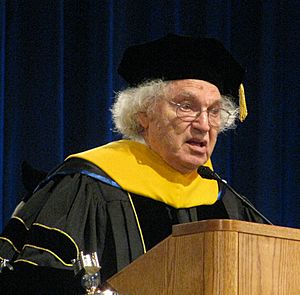Herbert A. Hauptman facts for kids
Quick facts for kids
Herbert A. Hauptman
|
|
|---|---|

Hauptman in 2009
|
|
| Born |
Herbert Aaron Hauptman
February 14, 1917 |
| Died | October 23, 2011 (aged 94) |
| Nationality | American |
| Alma mater | City College of New York Columbia University University of Maryland |
| Spouse(s) | Edith Citrynell (m. 1940; 2 children) (1918–2012) |
| Awards | Nobel Prize in Chemistry (1985) (jointly with Jerome Karle) Dirac Medal (1991) |
| Scientific career | |
| Fields | Mathematics |
| Institutions | Hauptman-Woodward Medical Research Institute University at Buffalo |
Herbert Aaron Hauptman (born February 14, 1917 – died October 23, 2011) was an American mathematician. He was also a Nobel laureate, meaning he won a Nobel Prize. He created a special mathematical method. This method changed how scientists study the tiny structures of crystallized materials.
Today, Hauptman's "direct methods" are used all the time. They help scientists figure out complicated structures. His work helped many areas of chemistry. Because of his important discoveries, he shared the 1985 Nobel Prize in Chemistry with Jerome Karle.
Contents
Early Life and Education
Herbert was born in New York City. He was the oldest child in his Jewish family. His parents were Leah and Israel Hauptman. He married Edith Citrynell on November 10, 1940. They had two daughters, Barbara and Carol.
From a young age, Herbert loved science and mathematics. He studied these subjects at Townsend Harris High School. He earned his first degree from the City College of New York in 1937. In 1939, he received a master's degree in mathematics from Columbia University.
Developing Direct Methods
After a period of war, Herbert started working with Jerome Karle. They worked at the United States Naval Research Laboratory in Washington, D.C.. At the same time, Herbert studied for his Ph.D. at the University of Maryland. He earned his Ph.D. in physics in 1955.
Herbert combined his knowledge of mathematics and physical chemistry. This helped him and Karle work on a big problem. It was called the "phase problem" in X-ray crystallography. Many people thought this problem could not be solved.
By 1955, they had created the basic ideas for "direct methods." Their 1953 book, "Solution of the Phase Problem I. The Centrosymmetric Crystal," explained their main ideas. A very important part was using probability to solve the problem.
Later Career and Beliefs
In 1970, Herbert joined the crystallographic group. This group was part of the Medical Foundation of Buffalo. He became the Research Director there in 1972. During this time, he developed new theories. These theories helped improve his direct methods even more.
Herbert was an atheist and a secular humanist. In 2003, he was one of 22 Nobel laureates who signed the Humanist Manifesto. This document shares beliefs about human values and reason.
Contributions and Leadership
Herbert Hauptman wrote over 170 publications. These included articles, papers, chapters, and books. In 1970, he joined the Hauptman-Woodward Medical Research Institute. This institute was formerly the Medical Foundation of Buffalo. He became its Research Director in 1972.
Until his death, he was the President of the Hauptman-Woodward Medical Research Institute. He was also a Research Professor at the University at Buffalo. Before coming to Buffalo, he worked as a mathematician at the United States Naval Research Laboratory starting in 1947.
Awards and Honors
Herbert Hauptman received many awards and honors for his important work:
- Belden Prize in Mathematics, City College of New York, 1936
- Scientific Research Society of America, Pure Science Award, United States Naval Research Laboratory, 1959
- President, Philosophical Society of Washington, 1969–1970
- President of the Association of Independent Research Institutes, 1979–1980
- Patterson Award from the American Crystallographic Association, 1984
- Nobel Prize in Chemistry, 1985 (shared with Jerome Karle)
- Honorary degree from the University of Maryland, 1985
- Honorary degree from City College of New York, 1986
- Citizen of the Year Award, Buffalo Evening News, 1986
- Norton Medal, SUNY, 1986
- Schoellkopf Award, American Chemical Society (Western New York Chapter), 1986
- Golden Plate Award of the American Academy of Achievement, 1986
- Cooke Award, SUNY, 1987
- Establishment of the Eccles-Hauptman Student Award, SUNY, 1987
- Election to the National Academy of Sciences, 1988
- Humanist Laureate Award from the International Humanist and Ethical Union, 1988
- Honorary degree from the University of Parma, Italy, 1989
- Honorary degree from the D'Youville College, Buffalo, New York, 1989
- Honorary degree from Bar-Ilan University, Israel, 1990
- Honorary degree from Columbia University, 1990
- Honorary degree from Technical University of Lodz, Poland, 1992
- Honorary degree from Queen's University, Kingston, Canada, 1993
- Honorary degree from SUNY at Buffalo, Buffalo, New York, 2009
See also
 In Spanish: Herbert A. Hauptman para niños
In Spanish: Herbert A. Hauptman para niños

